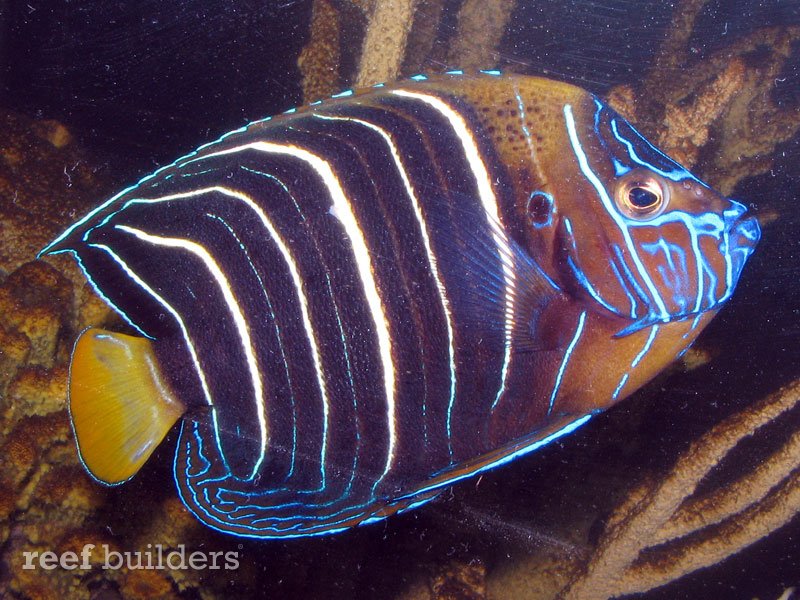
I often hear fellow hobbyists taking about the risk keeping a certain type of fish in their reef tank. Usually, it’s that beloved Angelfish or ultra-cool Butterflyfish that the hobbyist simply cannot resist! I know- I deal with this all the time. It’s the fine art of balancing what you want to keep with what you must keep- and it requires planning, risk-taking, and sometimes, a gut-check as an aquarist.
Let’s face it, to keep a fish that is a known coral-sampler in a reef tank takes a special breed of hobbyist- one who values his favorite fish over his love of corals. It’s a matter of balance, really. I mean, if you just have to keep a Chaetodontoplus conspicillatus in your aquarium, you are certainly going to have to accept the fact that some collateral damage to your corals may occur. On the other hand, if you love your Tyree Purple Monster colony more than some $2,500 Angelfish- just forget about it (But what dork would choose a coral over a fish? Sheesh!!). Or, you could compromise.
That’s right- compromise-a word that we don’t often use in reefkeping. It simply means that if you want to keep that potentially coral-nipping fish in your tank stocked with prized corals, no one is going to feel sorry for you if the fish mows down your entire zoanthid collection. On the other hand, if you accept the fact that some corals will be nipped, and restrain yourself from keeping the uber-rare collectible ones in the tank with your Centropyge eibli/Centropyge flavissima hybrid, you can make it work.
Learn to love the more commonly available varieties of captive-propagated coral, which can more readily and affordably be replenished when they get wacked by your Angelfish. Oh sure, there are a lot of hobbyists out there that will indignantly scream, “Why expose ANY corals to the potential of being eaten by a fish? I can’ t say I have an answer, other than we need to accept the responsibility for our decisions and be comfortable with the ethics of them. The other alternative is a Fish Only with Live Rock (FOWLR) tank-the ultimate expression of marine hobby compromise, IMO.
Of course, you can also alter your husbandry a bit and simply feed the crap out of your favorite fish to keep them satisfied most of the time, thus reducing snacking incidents as much as possible. (I need to teach my girlfriend this principle with me!) Here’s an idea: Spend some time on sites like fishbase.org and see what stomach content analysis of wild-specimens of your dream fish reveals about their diets, and try to provide that item if possible. If it’s small, free-swimming and tasty, chances are good that live-food guys like Randy Reed have something like it available for the hobby. On the other hand, if a significant percentage of the fish’s natural diet is live coral polyps (as opposed to coral mucous), you’ve got to make that most difficult of calls for a reefer.
Let’s be serious about one thing- there is little likelihood that a fish which incorporates coral as the majority of its diet will suddenly switch to an exclusive diet of Tetramin, but it may certainly learn over time to accept other foods as a substitute. Look at the wonderful work being done with Orange Spot Filefish by my man Matt Pederson. Hell, the guy is breeding them and getting them to accept mysids and other foods as the bulk of their diet. Now I’m not saying that you’ll get your Centropyge nigriocella to thrive on freeze-dried Tubifex worms, but I am saying that you can certainly experiment with a wide variety of available foods while the fish is in quarantine (oh yeah- you’ve heard of that process, right?). Or, you could simply get really good at propagating “feeder” Pocillopora. There is almost always an argument that can be made for experimentation. Almost.
To summarize my rambling, it’s really a matter of your personal interest and love of corals versus fish. For many of us, the choice is clear and one will always win out over the other. To others, the choice is not so clear-cut, and we’ll make the call based on our willingness to accept the risk. If that once-in-a-lifetime opportunity to get a Centropyge debelius comes along, you really have to decide if you-and your aquarium-are up for the challenge and risk. Have no regrets. Because if you don’t make the call, John Coppolino will! And he’ll be the first to tell you it was an easy decision, too!
You may not be able to have it all in a reef system, but you can have most of it! I think.
Till next time,
Stay wet…
Scott Fellman
facebook.com/scott.fellman



